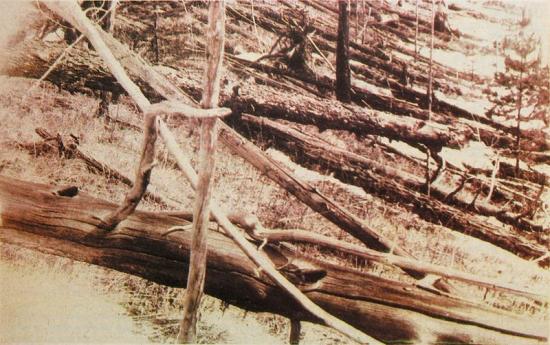Bob Yirka report
Source - http://phys.org/news/2014-05-team-evidence-extraterrestrial-impact-younger.html#ms

Trees were knocked down and burned over hundreds of square km by the Tunguska meteoroid impact. This image is cropped from the original, taken in May 1929 during the Leonid Kulik expedition. Credit: public domain
A team of researchers with members from several universities in the U.S. has published a paper in the journal Proceedings of the National Academy of Sciences, claiming that evidence supporting the notion that the Younger Dryas deep freeze was caused by an extraterrestrial impact or atmospheric explosion, is lacking. They go so far as to say that at this time, there is no real evidence of any such impact at all.
Scientists agree that something pretty big happened 12,800 years ago—the entire planet suddenly grew colder, allowing a cold weather blooming plant known as the Dryas octopetala to suddenly thrive. Mammoths in what is now the United States went extinct, so did the people that hunted them, the Clovis. Scientists have offered several ideas to help explain the sudden cold snap, which lasted over a thousand years, but thus far, no one has been able to prove what actually happened.
The best explanation, until now, came from a group of archeologists who claimed in a paper (and several others thereafter) published in 2007, that they'd found evidence of an extraterrestrial impact or atmospheric explosion as the source of the deep freeze. It had left a thin layer of sediment over the world's land masses, they claimed, leaving evidence behind which they'd found. In this new effort, the research team says a closer look has revealed that of the 29 sites referenced by the earlier team, only 3 could be dated to 12,800 years ago, which they claim, totally refutes the teams' findings.
The 29 sites were spread across the globe, most based on sediments that the 2007 team had concluded had components that proved it came from an extraterrestrial source—tiny diamonds that had been formed due to the high pressure at impact, for example. Others sources consisted of soot and charcoal that were supposedly caused by fires ignited by the blast. The research team visited all 29 sites and performed radioactive analysis dating techniques on the found materials and report that only 3 of the sites could be dated closely to 12,800 years ago. The rest were either younger or older, some by as much as a hundred years. They also noted that in fact-checking the original paper from 2007 that some of the supporting work was weak—some dated material had come from other sites, and some were actually approximated using non-standard techniques.
All in all, the researchers report, there is no conclusive evidence supporting the claim of an extraterrestrial impact causing the Younger Dryas deep freeze. Thus, more work must be done to find out what really happened.
More information: Chronological evidence fails to support claim of an isochronous widespread layer of cosmic impact indicators dated to 12,800 years ago, David J. Meltzer, et al. PNAS, DOI: 10.1073/pnas.1401150111
Abstract
According to the Younger Dryas Impact Hypothesis (YDIH), ∼12,800 calendar years before present, North America experienced an extraterrestrial impact that triggered the Younger Dryas and devastated human populations and biotic communities on this continent and elsewhere. This supposed event is reportedly marked by multiple impact indicators, but critics have challenged this evidence, and considerable controversy now surrounds the YDIH. Proponents of the YDIH state that a key test of the hypothesis is whether those indicators are isochronous and securely dated to the Younger Dryas onset. They are not. We have examined the age basis of the supposed Younger Dryas boundary layer at the 29 sites and regions in North and South America, Europe, and the Middle East in which proponents report its occurrence. Several of the sites lack any age control, others have radiometric ages that are chronologically irrelevant, nearly a dozen have ages inferred by statistically and chronologically flawed age–depth interpolations, and in several the ages directly on the supposed impact layer are older or younger than ∼12,800 calendar years ago. Only 3 of the 29 sites fall within the temporal window of the YD onset as defined by YDIH proponents. The YDIH fails the critical chronological test of an isochronous event at the YD onset, which, coupled with the many published concerns about the extraterrestrial origin of the purported impact markers, renders the YDIH unsupported. There is no reason or compelling evidence to accept the claim that a cosmic impact occurred ∼12,800 y ago and caused the Younger Dryas.